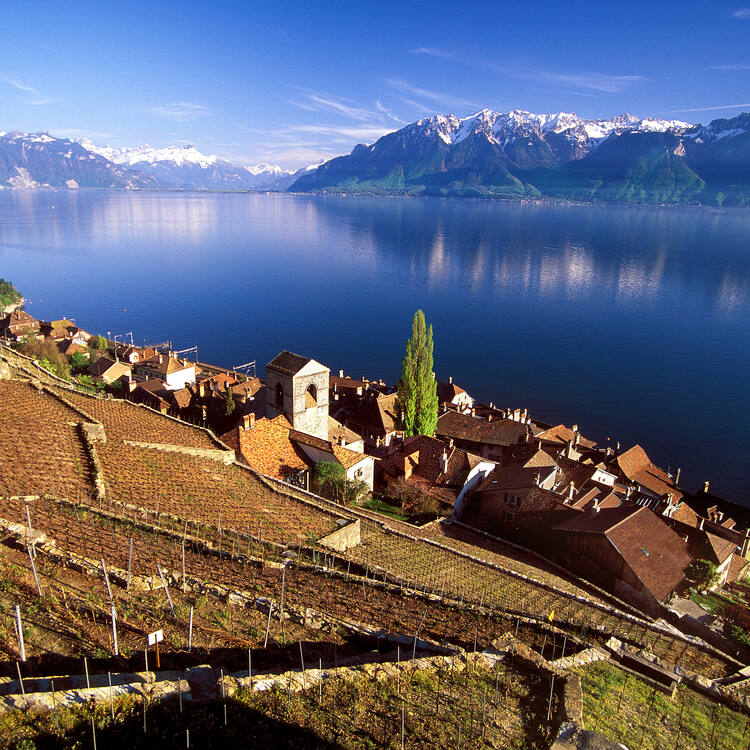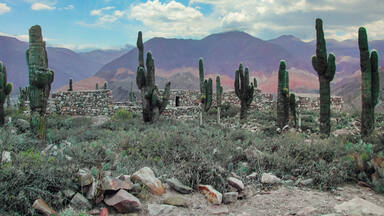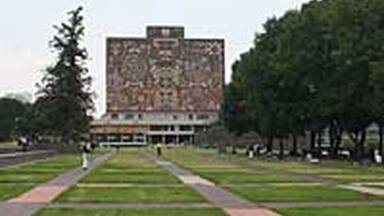Lavaux, Vineyard Terraces
Lavaux, Vineyard Terraces
The Lavaux Vineyard Terraces, stretching for about 30 km along the south-facing northern shores of Lake Geneva from the Chateau de Chillon to the eastern outskirts of Lausanne in the Vaud region, cover the lower slopes of the mountainside between the villages and the lake. Although there is some evidence that vines were grown in the area in Roman times, the present vine terraces can be traced back to the 11th century, when Benedictine and Cistercian monasteries controlled the area. It is an outstanding example of a centuries-long interaction between people and their environment, developed to optimize local resources so as to produce a highly valued wine that has always been important to the economy.
Description is available under license CC-BY-SA IGO 3.0
Lavaux, vignoble en terrasses
S’étendant sur environ 30 km le long du versant orienté au sud des berges du lac Leman, du château de Chillon, juste au sud de Montreux, jusqu’aux faubourgs orientaux de Lausanne au cœur du canton de Vaud, les étroites terrasses, soutenues par des murs en pierre, couvrent le bas des pentes fortement inclinées entre les villages et le lac. Bien qu’il y ait des preuves que les vignes ont commencé à être cultivées dans les environs au temps des Romains, les vignobles en terrasses actuels remontent au XIe siècle, quand les monastères bénédictins et cisterciens contrôlaient la région. Le site est un exemple exceptionnel de l’interaction pluriséculaire entre les hommes et leur environnement, développé pour optimiser les ressources locales afin de produire un vin très apprécié qui a toujours été important pour l’économie locale.
Description is available under license CC-BY-SA IGO 3.0
لافو، حقول الكروم المطلة على بحيرة جنيف وجبال الألب
تمتد كروم لافو على 30 كيلومتراً على طول الشواطئ الشمالية لبحيرة جنيف، من قصر شيلون (جنوب مدينة مونترو) إلى الضواحي الشرقية لمدينة لوزان، وعلى المنحدرات الجبلية بين القرى والبحيرة. ورغم وجود أدلة على زراعة الكرمة في هذه المنطقة منذ الأزمنة الرومانية، فإن جذور الكروم الحالية تمتد إلى القرن الحادي عشر، حينما كان الرهبان البندكتيون يسيطرون على المنطقة. ولطالما عُرفت كروم لافو بخمرها الجيد والباهظ الثمن، وقد جرى تطويرها لبلوغ الحد الأقصى من العائدات على الأديرة والأقاليم وأصحاب الأراضي الأثرياء. كما تعرض مشاهد القرى والمدن الصغيرة والكروم الكثيفة التغيرات المتعاقبة على نظام الإنتاج على مدى عشرة قرون. وبات الموقع يشكل منظراً طبيعياً مزدهراً يتيح الإنتاج الآلي جزئياً. وتشير آثار المنازل والطواحين والأبراج المحصنة والمشاهد الطبيعية عموماً مراحل تطور إنتاج الخمر على مر الزمن. كما أن المشاهد الثقافية لكروم لافو تظهر جلياً مراحل نموها وتطورها لفترة تناهز ألف عام، من خلال صون المناظر والأبنية، وتكييف التقاليد الثقافية القديمة الخاصة بالمكان. فضلاً عن أن الموقع يقدم مثالاً استثنائياً للتفاعل القائم منذ قرون بين الجماعات البشرية وبيئتها الطبيعية التي طوِّرت لاستخراج الأفضل من الموارد المحلية بهدف إنتاج خمر عالي الجودة شكل دوماً أحد أبرز عناصر الاقتصاد المحلي. وتجدر الإشارة إلى أن المجتمعات المحلية تدعم بقوة إجراءات الحماية لمقاومة المستوطنات البشرية النامية بشكل متسارع والتي من شأنها أن تمثل تهديداً على المنطقة.
source: UNESCO/CPE
Description is available under license CC-BY-SA IGO 3.0
拉沃葡萄园梯田
拉沃葡萄园梯田起于蒙特勒南部的西庸古堡,沿日内瓦湖北岸向南绵延约30公里,直至沃州中部的洛桑东郊,包括村舍与湖水之间的山腰斜坡。尽管有证据显示在罗马时代就有葡萄生长,但现在的葡萄园却要追溯到11世纪,当时这一地区由本笃会和西多会的修道士控制。这里的乡村景观、小城镇以及密集种植的葡萄体现了十多个世纪以来生产和惠益体系的变化。葡萄园中留有大量的房屋、磨坊和堡垒遗迹,许多景观都反映了酿酒方式在不同时期的演变。通过保存下来的景观和建筑物,以及对经久不衰的文化传统和地区特色的传承和发展,拉沃葡萄园的文化景观清晰展现了千余年来的演变和发展。此外从中也可以看出,几个世纪以来,为优化当地资源,酿造对当地经济具有重要价值的高品质葡萄酒,人类和环境之间进行着互动。当地社区一直大力支持采取保护措施,抵抗快速发展的城市住区,因为这会危及当地景观。
source: UNESCO/CPE
Description is available under license CC-BY-SA IGO 3.0
Террасовые виноградники Лаво
Террасовые виноградники Лаво растянулись на 30 километров на крутых южных склонах, спускающихся к Женевскому озеру, - от замка Шилон, на юге Монтрё, до восточных пригородов Лозанны. Они представляют собой узкие террассы, укрепленные каменными стенами. Здесь начали выращивать виноград еще в период Римской империи, но сегодняшние посадки датируются XI веком, когда этими землями владели бенедиктинские монахи. Террасовые виноградники Лаво являются уникальным примером многовекового взаимодействия человека и окружающей среды, ориентированного на оптимальное использование местных ресурсов для производства высококачественного вина, которое здесь очень ценится и играет важную роль в экономике края. Местные общины активно поддерживают меры в защиту природы, стремясь тем самым противостоять угрозе галопирующей урбанизации.
source: UNESCO/CPE
Description is available under license CC-BY-SA IGO 3.0
Viñedos en terraza de Lavaux
Los viñedos en terrazas de Lavaux, ubicados en la vertiente orientada al sur de la orilla septentrional del Lago Leman, se extienden a lo largo de 30 kilómetros, desde el castillo de Chillon, situado al sur de Montreux, hasta el límite de los arrabales este de la ciudad de Lausana, en el centro del Cantón de Vaud. Las estrechas y empinadas terrazas, apuntaladas por muros de piedra, cubren la parte baja de la pendiente montañosa entre los pueblos y el lago. Aunque existen indicios del cultivo de la viña en Lavaux desde tiempos del Imperio Romano, los bancales de viñedos actuales datan del siglo XI, época en que los monasterios de las órdenes benedictina y cisterciense dominaban la región. El sitio es un ejemplo excepcional de la interacción secular entre el hombre y el medio ambiente encaminada a la optimización de los recursos locales para producir un vino sumamente apreciado, que siempre ha tenido una importancia considerable en la economía de la comarca.
source: UNESCO/CPE
Description is available under license CC-BY-SA IGO 3.0
ラヴォー地区の葡萄畑
ラヴォー地区の葡萄畑は、ローザンヌの東部郊外からモントレー郊外のシヨン城までの約30㎞にわたり、レマン湖沿いの丘陵に広がる。スイス屈指のワイン産地であるこの地域では、ローマ時代にワイン生産が開始されたが、組織的な生産が始まったのは、カトリックお修道会であるベネディクト会とシトー会がラヴォーを支配した11世紀。14世紀には、現在のような石壁で区切られた段々畑が築かれたといわれる。テラスのような葡萄畑、教会や城、ワイン貯蔵室、生産者の住居からなる村が織り成す文化的景観は、人びとがこの地の都市化を拒み、伝統的なワイン生産を約10世紀にわたって受け継いできた賜物である。source: NFUAJ
Lavaux wijngaardterrassen
De Lavaux wijngaardterrassen liggen langs de noordelijke oever van het meer van Genève. Het gebied strekt zich 30 kilometer uit over de lagere hellingen tussen Château de Chillon en Lausanne. Er is bewijs gevonden van wijnbouw tijdens de Romeinse tijd, maar de huidige wijnstokterrassen zijn terug te voeren tot de 11e eeuw. Toen kregen Benedictijner en Cisterciënzer kloosters het gebied in handen. De Lavaux wijngaardterrassen is een goed voorbeeld van een eeuwenlange samenwerking tussen de mens en zijn omgeving en het optimale gebruik van de omgeving om een zeer gewaardeerde wijn te produceren die altijd belangrijk is geweest voor de economie.
Source: unesco.nl
Outstanding Universal Value
The Lavaux vineyard landscape is a thriving cultural landscape that demonstrates in a highly visible way its evolution and development over almost a millennia, through the well preserved landscape and buildings, and also the continuation and adaptation of longstanding cultural traditions, specific to its locality. It also illustrates very graphically the story of patronage, control and protection of this highly valued wine growing area, all of which contributed substantially to the development of Lausanne and its Region and played a significant role in the history of the geo-cultural region; and, has prompted, in response to its vulnerability next to fast-growing settlements, exceptional popular protection.
Criterion (iii): The Lavaux vineyard landscape demonstrates in a highly visible way its evolution and development over almost a millennium, through the well preserved landscape and buildings that demonstrate a continuation and evolution of longstanding cultural traditions, specific to its locality.
Criterion (iv): The evolution of the Lavaux vineyard landscape, as evidenced on the ground, illustrates very graphically the story of patronage, control and protection of this highly valued wine growing area, all of which contributed substantially to the development of Lausanne and its Region and played a significant role in the history of the geo-cultural region.
Criterion (v): The Lavaux vineyard landscape is an outstanding example that displays centuries of interaction between people and their environment in a very specific and productive way, optimising the local resources to produce a highly valued wine that was a significant part of the local economy. Its vulnerability in the face of fast-growing urban settlements has prompted protection measures strongly supported by local communities.
The nominated boundaries include all the elements of the wine growing process, and the extent of the traditional wine growing area since at least the 12th century. The terraces are in continuous use and well maintained. They have evolved over several centuries to their present form; there is now agreement that change needs to be tempered by respect for local traditions.
Strong protection has evolved as a reaction to the creeping urbanization from the growing towns of Lausanne to the west and the Vevey-Montreux conurbation to the east. This Protection is provided by: the Federal Loi sur l'aménagement du territoire (LAT), the Inventaire fédéral des paysages, sites et monuments naturels (IFP) resulting from the LAT, its Inventaire fédéral des sites construits (ISOS), the cantonal Loi sur le plan de protection de Lavaux (LPPL), the cantonal Inventaire des monuments naturels et des sites (IMNS), and the cantonal land-use plan (Plan général d'affectation - PGA) and its building regulations (RPGA). A buffer zone has been established. The state of conservation of the villages, individual buildings, roads and footpaths, and vineyard plots within the nominated area is high. A Management Plan has been approved for the property. It provides an analysis of socio-economic data, and a series of management strategies for research and culture, economy, land-use planning and tourism.

 View photos from OUR PLACE the World Heritage collection
View photos from OUR PLACE the World Heritage collection

